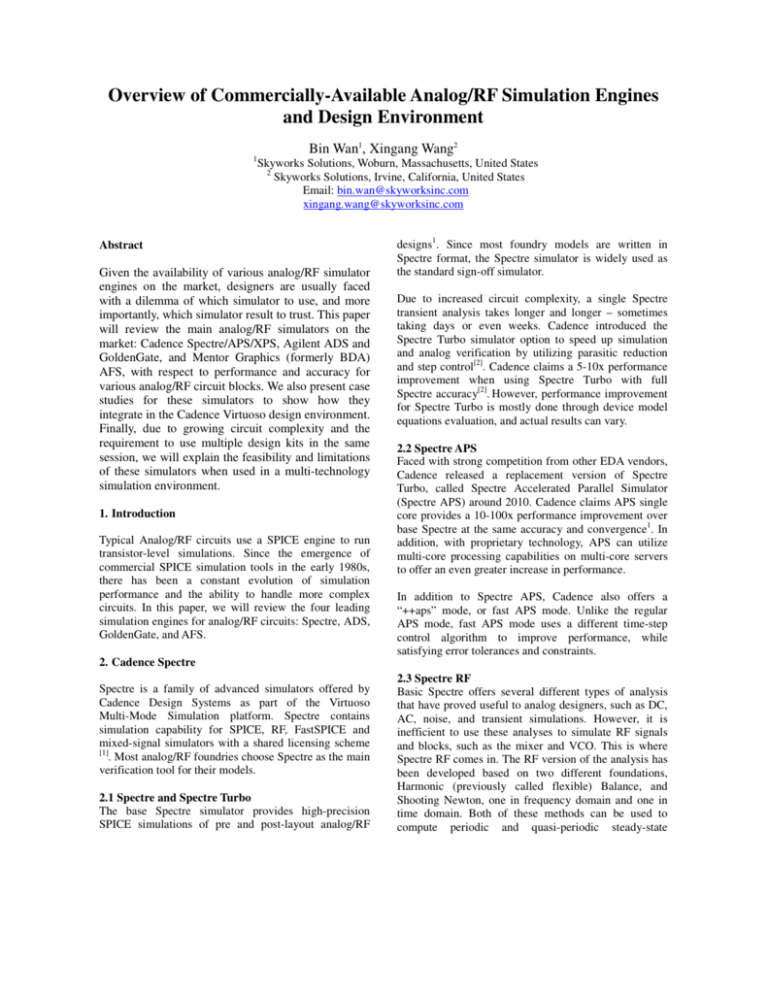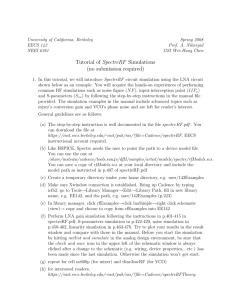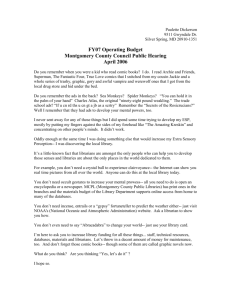Overview of Commercially-Available Analog/RF Simulation Engines
advertisement

Overview of Commercially-Available Analog/RF Simulation Engines and Design Environment Bin Wan1, Xingang Wang2 1 Skyworks Solutions, Woburn, Massachusetts, United States 2 Skyworks Solutions, Irvine, California, United States Email: bin.wan@skyworksinc.com xingang.wang@skyworksinc.com Abstract Given the availability of various analog/RF simulator engines on the market, designers are usually faced with a dilemma of which simulator to use, and more importantly, which simulator result to trust. This paper will review the main analog/RF simulators on the market: Cadence Spectre/APS/XPS, Agilent ADS and GoldenGate, and Mentor Graphics (formerly BDA) AFS, with respect to performance and accuracy for various analog/RF circuit blocks. We also present case studies for these simulators to show how they integrate in the Cadence Virtuoso design environment. Finally, due to growing circuit complexity and the requirement to use multiple design kits in the same session, we will explain the feasibility and limitations of these simulators when used in a multi-technology simulation environment. 1. Introduction Typical Analog/RF circuits use a SPICE engine to run transistor-level simulations. Since the emergence of commercial SPICE simulation tools in the early 1980s, there has been a constant evolution of simulation performance and the ability to handle more complex circuits. In this paper, we will review the four leading simulation engines for analog/RF circuits: Spectre, ADS, GoldenGate, and AFS. designs1. Since most foundry models are written in Spectre format, the Spectre simulator is widely used as the standard sign-off simulator. Due to increased circuit complexity, a single Spectre transient analysis takes longer and longer – sometimes taking days or even weeks. Cadence introduced the Spectre Turbo simulator option to speed up simulation and analog verification by utilizing parasitic reduction and step control[2]. Cadence claims a 5-10x performance improvement when using Spectre Turbo with full Spectre accuracy[2]. However, performance improvement for Spectre Turbo is mostly done through device model equations evaluation, and actual results can vary. 2.2 Spectre APS Faced with strong competition from other EDA vendors, Cadence released a replacement version of Spectre Turbo, called Spectre Accelerated Parallel Simulator (Spectre APS) around 2010. Cadence claims APS single core provides a 10-100x performance improvement over base Spectre at the same accuracy and convergence1. In addition, with proprietary technology, APS can utilize multi-core processing capabilities on multi-core servers to offer an even greater increase in performance. In addition to Spectre APS, Cadence also offers a “++aps” mode, or fast APS mode. Unlike the regular APS mode, fast APS mode uses a different time-step control algorithm to improve performance, while satisfying error tolerances and constraints. 2. Cadence Spectre Spectre is a family of advanced simulators offered by Cadence Design Systems as part of the Virtuoso Multi-Mode Simulation platform. Spectre contains simulation capability for SPICE, RF, FastSPICE and mixed-signal simulators with a shared licensing scheme [1] . Most analog/RF foundries choose Spectre as the main verification tool for their models. 2.1 Spectre and Spectre Turbo The base Spectre simulator provides high-precision SPICE simulations of pre and post-layout analog/RF 2.3 Spectre RF Basic Spectre offers several different types of analysis that have proved useful to analog designers, such as DC, AC, noise, and transient simulations. However, it is inefficient to use these analyses to simulate RF signals and blocks, such as the mixer and VCO. This is where Spectre RF comes in. The RF version of the analysis has been developed based on two different foundations, Harmonic (previously called flexible) Balance, and Shooting Newton, one in frequency domain and one in time domain. Both of these methods can be used to compute periodic and quasi-periodic steady-state solutions of a circuit[3]. Spectre RF was first introduced as shooting analysis[4]. The main Spectre RF shooting analysis includes Periodic Steady-State, Periodic AC, Periodic SP, Periodic Noise, and the Quasi-periodic versions. With the more recent releases of MMSIM product lines, harmonic balance, and envelope analyses have been introduced to fulfill all of the RF circuit types. 2.4 Analog Design Environment In addition to the Spectre family of simulators, Cadence Virtuoso also offers a comprehensive design platform. The Analog Design Environment (ADE) within Virtuoso acts as the main interface between the simulator and circuit schematics to speed up the simulation setup. Within ADE, the user can setup the models, pick various analyses, setup outputs, and plot the results. Since the release of Cadence Virtuoso IC6.1.X, users have an even greater control of the simulation environment inside ADE XL and ADE GXL. 3. Agilent ADS The Agilent Advanced Design System (ADS) is comprehensive design automation software that provides an integrated design environment of RF circuit blocks. ADS provides a best-in-class harmonic balance simulator for RF simulations. In addition, Momentum also provides a 2.5D electromagnetic (EM) simulation capability within ADS. Therefore, ADS is the preferred design environment used by RF designers. 3.1 ADS Simulation Engine The ADS simulation engine is well known as one of the best RF simulation engines. It has a unique harmonic balance non-linear engine which outperforms the competitors. ADS also has provided the specialized RF analysis, such as X-Parameter5. 3.2 ADS Design Environment ADS supports the entire RF design flow – schematic capture, frequency and time-domain simulation, electromagnetic simulation, and layout. Momentum EM simulation capability can be used to simulate passive devices and RF. Data display also provides another nice feature for post data processing. 3.3 ADS Dynamic Link The drawback of ADS design environment is the lack of a good layout suite. Compared to the competition, especially with the Cadence Virtuoso layout suite, the ADS layout is noticeably inferior. However, given the superiority of the simulation environment, many users still want to use ADS for RF simulations. Hence, Agilent released the Dynamic Link flow, which allows the user to link a Cadence schematic into the ADS environment for simulation. The simulation testbench is done in ADS but the core transistor blocks are done in Cadence. During netlisting, ADS requests Cadence to netlist and then includes the Cadence spectre netlist inside the ADS main netlist. Since ADS can read the spectre netlist format, the simulation will run purely inside ADS and the resulting data will be shown on ADS data display window. The significance of this design flow is to allow the RF designer to use a hybrid method to leverage different tools – ADS for simulation, Cadence for schematic capture and layout. Many analog/RF foundries have adopted this flow and provided their PDK to support it. 3.4 Agilent RFDE/ADE Integration Before Agilent’s acquisition of Xpedion, Agilent offered RF Design Environment (RFDE) to allow access to ADS simulator directly from Cadence’s ADE. Similar to ADS Dynamic Link, the user can use ADS’s data display to view simulation results. However, RFDE has not integrated many of ADS features into the Cadence ADE. After acquiring Xpedion in 2009, Agilent stopped improving RFDE integration with ADE. Instead they leverage GoldenGate to simulate within ADE. 4. Agilent GoldenGate Agilent GoldenGate claims to be the best-in-class RFIC simulator in the Cadence Virtuoso environment. It allows easy access to Agilent’s frequency-domain simulation technologies directly from ADE. The RF analyses offered by GoldenGate are based on Harmonic Balance methods. Like ADS, GoldenGate also provides many special RF analyses such as X-Parameters. Recent releases of GoldenGate have incorporated more and more ADS products, such as Momentum, SystemVue, and Ptolemy6. GoldenGate also has the capacity to simulate full characterization of a complete RF transceiver, including parasitics7. Unlike other simulators integrated inside ADE, GoldenGate offers several unique post-processing functionalities beyond features of standard Virtuoso ADE, such as the ADS data display. 5. Mentor Graphics AFS Analog FastSPICE (AFS) is a verification platform offered by Mentor Graphics, after Mentor Graphics’ acquisition of Berkeley Design Automation in 2014. AFS claims to deliver a 5-10x performance improvement over the traditional SPICE simulator and a 2-6x performance improvement over parallel SPICE simulators[8], with full-spectrum, single-tone RF analysis[9]. AFS is tightly integrated inside Cadence Virtuoso ADE and the output is directly readable by Cadence ViVA waveform tool. AFS also contains a mixed signal simulation tool with similar capability as Cadence AMS Designer. This puts AFS in direct competition with Spectre. 5.1 AFS vs. Spectre Generally speaking, AFS and Spectre can be used interchangeably in ADE. Most analyses available in Spectre are also available in AFS. AFS also seamlessly integrates into ADE and ADEXL, and can take advantage of many ADE XL features and distributed processing. In terms of performance of transient simulation, we observed AFS runs 30% faster against Spectre or APS with test cases we simulated based on the same number of cores with the same convergence settings. However, since AFS can only support a maximum of 8 cores while Spectre APS can support up to 64, APS can provide multi-core advantages over AFS with large netlists, assuming the availability of hardware and additional licenses required. One other potential issue is the accuracy of AFS vs. Spectre. Since Spectre is considered to be the golden simulator by many analog/RF foundries, most device models are validated against Spectre. AFS, on the other hand, is relatively new to the EDA market and untested by most foundries. While AFS can read Spectre-based models, we have found several instances where AFS can produce inaccurate results. However with AFS being part of the Mentor Graphics family now, it could speed up the process for foundries to adopt AFS and verify their models. 6. Multi-Technology Simulations Typical designers work with circuits composed with a single process and single design kit. However, with the desire to improve performance and drive down cost, many RF products are actually multi-chip modules consisting of many processes. For example, in a typical RF front-end, the PA might be built using a GaAs or SiGe process, the LNA/Switch might be built using an SOI process, and the controller might be built using an inexpensive CMOS process. The challenge to the designer is how to simulate the entire chip together? Traditional SPICE simulators will likely fail to simulate circuits with multiple design kits. The main reason is that the device name and model will have conflicts. For example, if a device model is called “nfet” in one process and a different process also has a device model called “nfet”, this will cause a problem for simulations. The same issue also exists for Verilog-A module names. To resolve this issue, SPICE-like simulators must localize the device model at the level in which they are being included. Both Cadence and Agilent recently enhanced their simulators to resolve model and Verilog-A module name conflicts with multi-technology simulation (MTS). In Cadence’s ADE GXL, a MTS utility is offered to provide an easy setup for MTS simulations. Agilent ADS also developed its own methodology to perform MTS. Mentor Graphics AFS is still working on enabling the MTS ability. 7. Best Applications Of all four major analog/RF simulators we have reviewed, each has its own unique strengths, as well as weaknesses. Depending on the application, some simulators might run very fast with great accuracy, while other simulators might stumble and fail to converge. In general, for circuit applications with a few frequency components, like LNA and mixer, the frequency-domain technique is more efficient, while time-domain technique is more efficient for circuits with abrupt edges, like controller logic. The Table shown below is a short performance summary based on simulators evaluated: Transient Single-tone RF Multi-tone RF Mixed-Signal Spectre1 ADS GoldenGate AFS ♦♦♦ ♦♦ ♦ ♦♦♦ ♦♦ ♦♦♦ ♦♦♦ ♦♦ ♦♦♦ ♦♦♦ N/A* ♦♦♦ N/A* N/A* ♦♦♦ Design ADE ADS ADE/ADS Environment MTS Support Yes Yes Yes ♦ Average Performance ♦♦ Good Performance ♦♦♦ Best Performance, based on our experiments 1 Spectre simulator family (APS, RF) N/A* No experiment result N/A* ADE No 7.1 Spectre Given the complete Virtuoso custom IC design flow and the smooth integration of Cadence’s products, the Spectre family is a leading simulator used in the mixed-signal and analog/RF design community. The basic Spectre SPICE engine remains the golden simulator for most foundry models. Spectre APS can utilize up to 64 cores for parallel simulation of giant design with near-Spectre accuracy. Spectre RF offers a strong set of time-domain analyses to provide complete analysis for analog/RF circuits. Digital, analog, and mixed signal circuits will benefit nicely from Spectre’s time-domain analyses. Recently Cadence also implemented a harmonic balance engine for RF analysis. But more innovation is required for Cadence to compete with traditional RF heavy weights like ADS. 7.2 ADS For RF systems, ADS offers one of the best harmonic balance simulation engines. Most RF designers also prefer to use ADS simulator for RF simulations due to the availability to run specialized RF analyses. The integration of Momentum EM simulator is also a plus. However, since silicon foundries provide Cadence-based PDKs due to Virtuoso layout suites being widely used in industry, ADS Dynamic Link is the preferred flow for RF simulations. The user can simply link the Cadence schematic into spectre netlist that ADS can read, while still leveraging ADS to build test-benches and view simulation results. ADS is best suited to simulate circuits like LNA, mixer, and PA in frequency domain. However, if the circuit contains many analog or custom digital blocks and transient simulation is required, ADS can take a very long time to simulate. 7.3 GoldenGate Given that GoldenGate is highly integrated into the Cadence Virtuoso flow, it is a nice alternative to ADS if users would like to work mainly in the Virtuoso flow, but still want to include ADS applications like Momentum and Data display. Like ADS, GoldenGate is also a very strong RF simulator with specialized RF analyses. RF blocks like LNA and mixer will benefit nicely with GoldenGate. 7.4 AFS AFS provides features to speed up transient simulations compared with traditional-Spectre engine. AFS has the capacity to simulate large-scale designs. The full integration of AFS within ADE provides designers with easy access. Like Spectre, AFS also offers a strong set of time-domain analyses, especially the AFS transient simulation, which we found to be the most efficient transient simulation engine at 4 CPU cores. 8. Summary We reviewed the basics of the four major simulators commercially available. All have their own strengths and weaknesses. Depending on the application and analysis algorithm, some simulators may run more efficiently than others. Based on our experience and in paper [7], we would recommend to simulate RF centric circuitry such as Mixer, LNA, PA, and Switch using HB simulators, and to simulate analog centric circuitry such as ADC/DAC, DC-DC converters and PAC Controllers using Spice-like simulators (Spectre/APS and AFS). The diagram below illustrates our recommendation for the best use of simulation techniques with different circuit applications: Acknowledgments We would like to thank the Design Enablement Group at Skyworks for their contributions to this work. References [1] Cadence Virtuoso Spectre Simulator Datasheet, http://www.cadence.com/rl/Resources/datasheets/virt uoso_mmsim.pdf#page=4, 2014. [2] Accelerating Analog Simulation with Full Spice Accuracy, Cadence White Paper, http://www.cadence.com/rl/Resources/white_paper s/spectre_turbo_wp.pdf, 2008. [3] Ken Kundert. Introduction to RF simulation and its application. Journal of Solid-State Circuits, vol. 34, no. 9, September 1999. [4] Virtuoso Spectre Circuit Simulator RF Analysis Theory, Product Version 13.1, September 2013. [5] Agilent ADS Brochure, agilent.com, 2014. [6] Agilent GoldenGate Brochure, agilent.com, 2014. [7] GoldenGate 440 What is New Presentation, Agilent, 2010. [8] Analog FastSPICE Platform Datasheet, http://www.berkeley-da.com/prod/datasheets/Berk eley_DA_Platform_DS.pdf, 2013. [9] Analog FastSPICE RF White Paper, http://www.berkeley-da.com/prod/datasheets/Berk eley_BDA_AFS_RF_WP.pdf, 2009.





